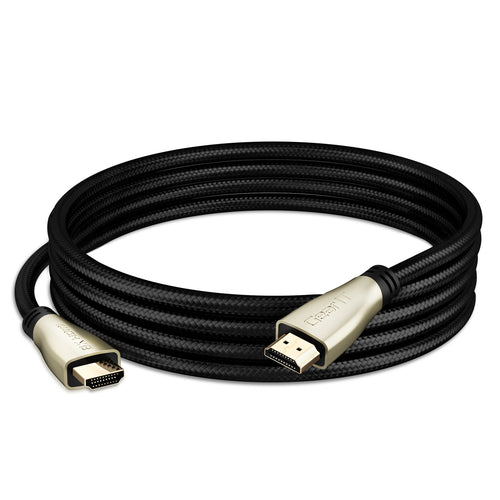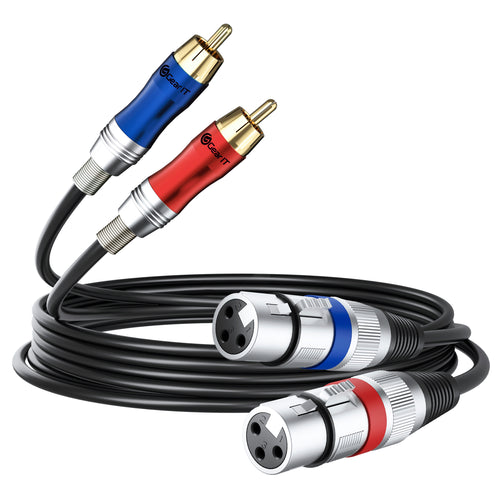Audio cable types play a big role in how your sound system performs. The right cable can make a difference in sound quality, whether you're using TS, TRS, or XLR cables.
Picking the right one helps ensure clear, strong audio with no interference. If you're setting up a home theater, live performance, or studio, choosing high-quality cables is key for durability and performance.
GearIt offers top-quality audio cables for every type, so you get the best connection possible. In this guide, we’ll break down the different audio cable types and help you find the perfect one for your setup!
What Are Audio Cable Types?
Audio cables are essential for transmitting audio signals between devices. They can be divided into two main categories: analog and digital.
Understanding these types helps you choose the right cable for your setup.
Analog Audio Cables
Analog audio cables transmit sound as continuous electrical signals. Common examples include RCA, AUX, and XLR cables.
These cables are known for their ability to deliver a "warm" sound, which some people prefer for instrument connections.
- RCA Cables: These are often used in home audio systems to carry stereo sound by using separate cables for left and right audio channels.
- AUX Cables: These cables are popular for connecting portable devices like smartphones to car stereos or home audio systems.
- XLR Cables: Common in professional audio settings, XLR cables provide a balanced signal, reducing noise and interference.
Analog cables rely heavily on quality shielding to prevent noise and maintain signal integrity.
Digital Audio Cables
Digital audio cables transmit sound as binary data. This means they are better at resisting interference and maintaining signal quality over longer distances.
- Optical Cables: Also known as Toslink, these use light to transfer audio signals, which reduces the chance of interference. They are often used in home theater systems.
- HDMI Cables: These cables are versatile, supporting both audio and video, making them ideal for connecting devices like TVs and game consoles.
When selecting digital cables, consider the connectors and cable quality since these affect how well signals are transmitted and received. Proper connectors ensure a tight fit, which is crucial to prevent signal loss.
Common Audio Cable Types and Their Uses
Audio cables are essential for connecting various devices to deliver sound. Here's a breakdown of common audio cable types, divided into analog and digital categories.
Analog Audio Cables
⟶ RCA Cables: RCA cables are often used in home audio systems. They connect devices like CD players, turntables, and amplifiers.
⟶ AUX (3.5mm) Cables: You use AUX cables for everyday devices like headphones, smartphones, and portable speakers.
⟶ XLR Cables: These are the go-to cables for microphones and professional audio equipment. They provide balanced connections for quality sound.
⟶ 1/4-Inch (TRS/TS) Cables: These cables are popular with musicians. You'd use them to connect instruments like guitars and studio equipment.
Speaker Cables: Ideal for connecting speakers to amplifiers, speaker cables are key in home theater systems and public address setups.
Digital Audio Cables
⟶ Optical (Toslink) Cables: Great for home theaters and soundbars, these cables transmit high-quality audio without interference.
⟶ HDMI Cables: HDMI cables carry both audio and video. You’d typically use them with TVs and gaming consoles.
⟶ USB Cables: In the digital world, USB cables connect audio interfaces, DACs, and digital instruments to your computer.
⟶ Coaxial Digital Cables: These cables are useful for transmitting digital audio in home theater setups. They ensure a reliable connection.
Balanced vs. Unbalanced Cables: Which One Do You Need?
Choosing the right cable is important for getting the best sound quality in your audio setup. The main difference between balanced and unbalanced cables is how they handle noise and interference. Let’s break it down so you can pick the right one for your needs.
What Are Balanced Cables?
Balanced cables are designed to reduce noise and interference, making them the best choice for professional audio setups like studios, concerts, and broadcasting.
How Do They Work?
- Three Wires: Inside a balanced cable, there are two signal wires and one ground wire.
- Noise Cancellation: The two signal wires carry the same audio signal, but one is flipped in phase. If the cable picks up any interference, the noise cancels itself out when the signal is flipped back at the end.
- Common Mode Rejection: This process keeps the sound clean and free from buzzing or humming.
Benefits of Balanced Cables
✔ Less interference: Perfect for long cable runs where outside noise (like electrical signals or radio waves) can be a problem.
✔ Clearer sound: Ensures high-quality audio transmission without unwanted noise.
✔ Better for professional use: Found in recording studios, live sound systems, and broadcasting setups.
✔ Uses XLR and TRS connectors: XLR cables (three-pin connectors) are common for microphones, while TRS cables (Tip-Ring-Sleeve) are often used for speakers and other audio equipment.
What Are Unbalanced Cables?
Unbalanced cables are simpler and more common in home audio setups and for musical instruments like guitars and keyboards.
How Do They Work?
- Two Wires: Unbalanced cables have one signal wire and one ground wire.
- More Interference: Since the cable only has one wire carrying the signal, any external noise (like radio signals or electrical interference) can be picked up and affect sound quality.
Drawbacks of Unbalanced Cables
✖ More prone to noise: If used over long distances, you might hear buzzing or humming.
✖ Weaker signal quality: Sound can degrade faster than in balanced cables.
Where Are Unbalanced Cables Used?
✔ Musical instruments: Guitars, basses, and keyboards often use unbalanced cables with TS (Tip-Sleeve) connectors.
✔ Short cable runs: Ideal for connecting home speakers or other devices where interference is less of a problem.
✔ Budget-friendly: They are cheaper and simpler to use for everyday audio needs.
Which One Should You Choose?
- For professional use, live performances, or long-distance connections: Balanced cables are the best choice because they prevent noise and keep your sound clear.
- For short-distance connections, home audio, or instruments: Unbalanced cables work fine and are easier to find and use.
By understanding the difference between balanced and unbalanced cables, you can make sure your audio setup sounds the best it can!
Analog vs. Digital Audio Cable Types: Key Differences
Signal Transmission
Analog cables carry audio through continuous electrical signals. This type of signal mimics the original sound waves. In contrast, digital cables transmit audio as binary data, using 1s and 0s. Digital signals are converted back to sound at the receiving end.
Sound Quality
Digital cables are often preferred for their ability to eliminate noise and distortion. The use of binary data reduces interference. Analog cables, while capable of providing warm sound, can pick up electrical noise, which may affect audio quality.
Compatibility
You’ll find analog connections in many traditional audio setups, including older stereo systems and musical instruments. Devices with digital connections include modern home theater systems and computers. Digital cables are generally more compatible with various audio formats, allowing for a wider range of use.
Use Cases
Choose analog cables for live audio setups where a natural sound is vital. These cables are often used in professional settings like concerts.
Digital cables are suitable for home theater systems, providing clean and high-quality sound. They are also ideal for recording studios where clarity and precision are paramount.
Understanding these differences helps you select the right cable for your audio needs.
Pros and Cons of Different Audio Cable Types
RCA Cables
- Pros: RCA cables are widely available and affordable, making them a common choice for connecting older audio equipment.
- Cons: They can be susceptible to interference and are typically limited to short distances, which might affect sound quality.
XLR Cables
- Pros: XLR cables provide a balanced signal, which is excellent for reducing noise over long distances. They are often used in professional settings.
- Cons: These cables are bulkier and more expensive compared to other analog options.
Optical Cables
- Pros: Optical cables are immune to electrical interference, providing a clear signal. They also support surround sound, making them ideal for high-quality audio setups.
- Cons: The cables are fragile and less flexible, which requires careful handling.
HDMI Cables
- Pros: HDMI cables can transmit both audio and video, offering broad compatibility with many devices. They are a great choice if you need to connect multiple media types.
- Cons: HDMI cables can be bulkier and may be excessive for audio-only setups, especially if video transmission is not needed.
Final Thoughts
Choosing the right audio cable is key to getting the best sound quality. Whether you need balanced XLR cables for pro setups, RCA for home audio, or TS cables for instruments, picking the right one makes a difference. Good cables help reduce noise, improve clarity, and keep your audio strong.
If you want high-quality, durable audio cables for any setup, GearIt has it all! From professional studio cables to home entertainment wires, you’ll find the best options to fit your needs.
Check out GearIt’s audio cables today and upgrade your sound setup!
Frequently Asked Questions
This section covers some essential questions about audio cables, focusing on the distinctions between different types, their uses, and whether high-end options are worth the investment. This will help you understand what might be best for your audio setup.
What's the difference between TRS and TS cables?
TRS (Tip, Ring, Sleeve) cables are balanced and often used where noise reduction is important, like in studio settings. On the other hand, TS (Tip, Sleeve) cables are unbalanced and typically used for instruments like guitars.
Is optical better than HDMI for audio?
Optical cables offer high-quality audio signal transmission but can't carry video. HDMI can transmit both audio and video, making it more versatile for home theaters. HDMI often supports higher sound quality formats.
Which are the 2 most common cables used in audio?
The two most common cables in audio setups are RCA cables and XLR cables. RCA cables are common in home audio devices, while XLR cables are used for professional audio equipment due to their balanced signal.
What cable is used for audio?
Several types of cables are used for audio, including RCA, XLR, TRS, TS, Optical (TOSLINK), and HDMI. The best choice depends on your audio setup and usage:
- RCA: Common in home audio and older AV systems.
- XLR: Used in professional audio for microphones and balanced connections.
- TRS/TS: Found in guitars, instruments, and headphones.
- Optical (TOSLINK): Used in home theater and gaming setups for digital audio.
- HDMI: Transfers both audio and video in modern AV systems.
Do expensive audio cables make a difference?
Expensive audio cables may offer better build quality, durability, and shielding against interference. However, for most casual listeners, the difference in sound quality is often minimal. The most important factors are:
- Proper shielding to prevent noise and interference.
- Good-quality connectors for a secure, stable connection.
- Durable materials to ensure longevity.
For professional use, high-quality cables can help maintain signal integrity over long distances. But for short, everyday use, well-made mid-range cables often perform just as well as expensive ones.
What is the best wire for audio signal?
The best wire for audio signals is copper, as it has excellent conductivity and low resistance, ensuring clear sound transmission. For high-end and professional setups, oxygen-free copper (OFC) is preferred because:
- It reduces signal loss over long distances.
- It is more resistant to corrosion, increasing lifespan.
- It ensures high-quality audio transmission with minimal interference.
For digital audio, fiber optic cables (TOSLINK) can also be a great option as they eliminate electrical interference completely.





















































